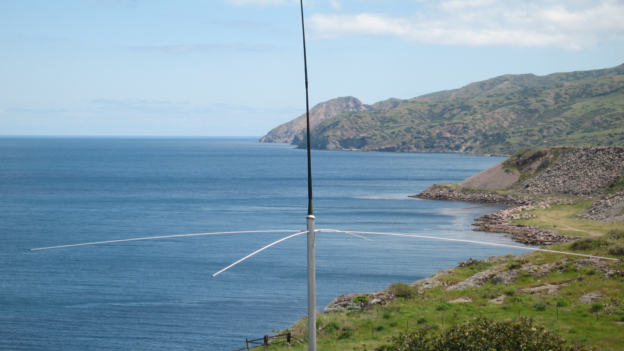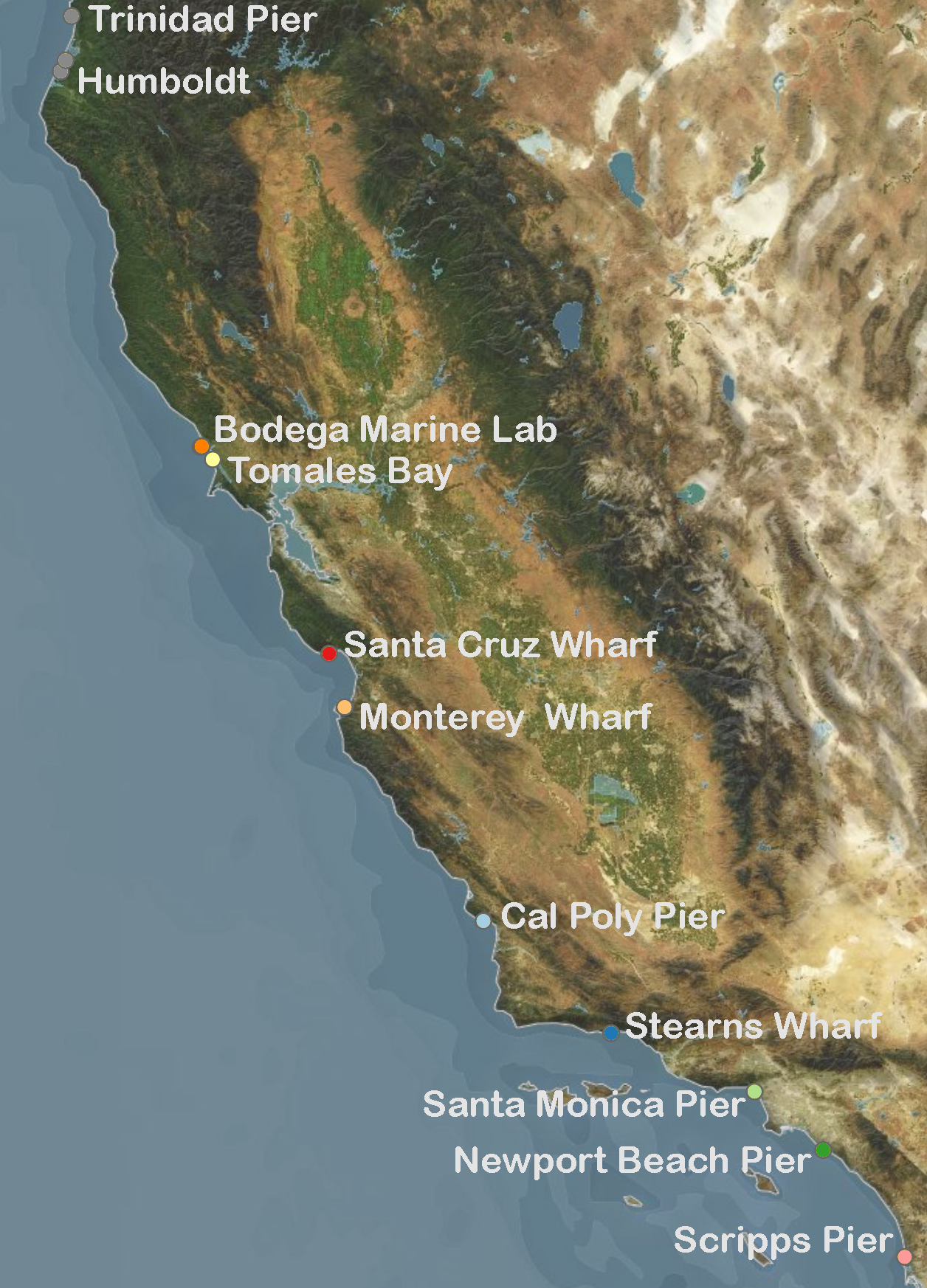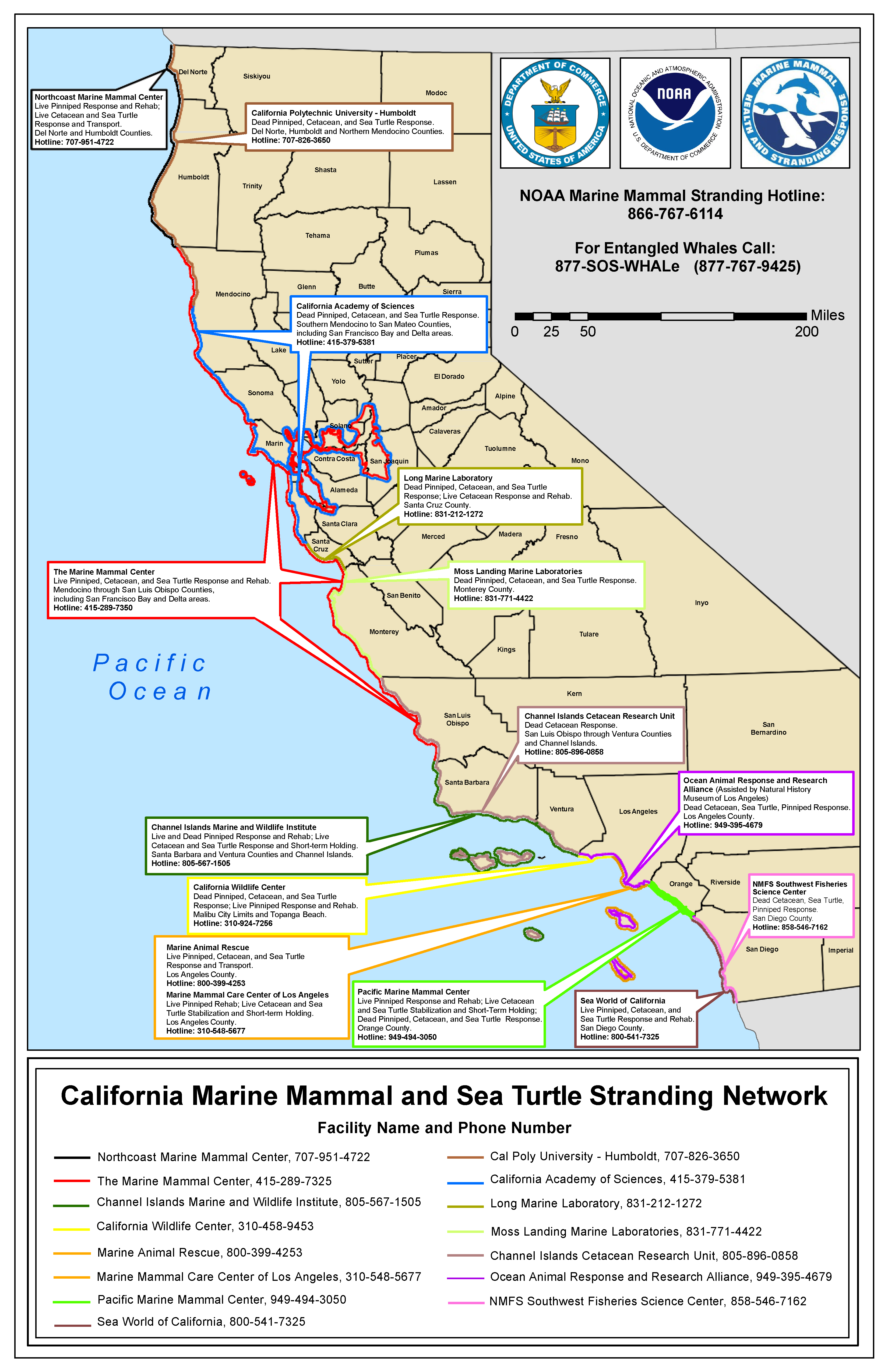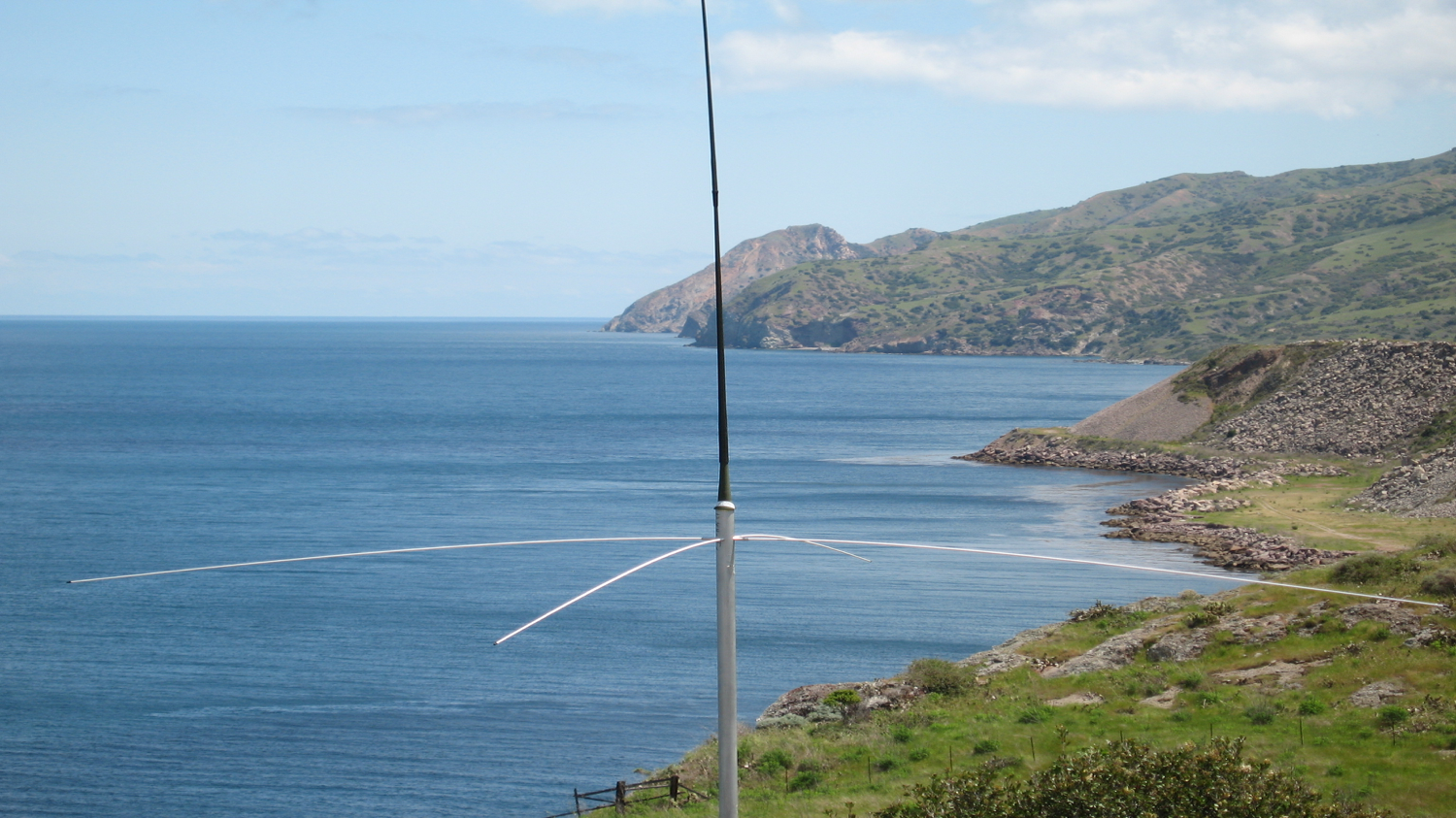September 2024
Summary written by Dr. Clarissa Anderson, 8 November 2024
– HAB Bulletin v2 –
The team welcomes any and all feedback on this new format of the California Harmful Algal Bloom bulletin, and extend our gratitude for your continued patience as we work through delays in development & data availability.- SUMMARY: In September, we saw a resurgence of the toxic Pseudo-nitzschia bloom of July-August and another peak in marine mammal strandings due to suspected domoic acid (DA) toxicosis in central to southern California. The duration of this event was shorter than the summer event but still resulted in reports of sick animals from San Luis Obispo to San Diego and a CDPH advisory on recreational harvesting of bivalves in Santa Barbara County due to risk of Amnesic Shellfish Poisoning.
- The C-HARM system predicted high probabilities of particulate DA events across a broad coastal swath from central to northern California throughout September, with high probabilities restricted to the coastline in the Southern California Bight region; Pseudo-nitzschia bloom probabilities followed the same pattern. High cellular DA event probabilities were shifted to central and northern California. This is consistent with the highest numbers of animals stranding from suspected DA toxicosis occurring in the Santa Barbara Channel and San Luis Obispo areas, as we saw earlier in the summer.
- HABMAP sampling at shore stations throughout California caught the early rise of the more toxigenic Pseudo-nitzschia “seriata” size class at Stearns Wharf (Santa Barbara) in early September before it hit bloom levels (>10,000 cells/L). We did not see the same rise in any Pseudo-nitzschia cells at Cal Poly Pier, suggesting a Santa Barbara Channel origin to this bloom. HABMAP hero, Amber Briesach, notes for Stearns Wharf: “Higher DA concentrations occurred when there were high numbers of PN “seriata” cells present in the water column. PN “delicatissima” was noted on all days sampled except September 23rd, which was also the highest DA concentration seen at the [Stearns] Wharf in the past several years. The rise in DA from early to mid September at Stearns Wharf coincided with a rapid increase along the SB Channel and central coast region of CA Sea Lion strandings with symptoms of DA intoxication. These numbers peaked in mid September. Even though some animals, albeit fewer, did strand further south in Los Angeles, Orange County, and San Diego, HABMAP sites in that region did not record any DA activity and only caught bloom levels of Pseudo-nitzschia “delicatissima” at one site, Newport Beach Pier, on Sep 23rd. Northern California shore stations were fairly quiescent in September based on the level of data collected by HABMAP, leading to a lifting of the ASP advisory from CDPH in Humboldt County on October 8th.
- Imaging FlowCytobot (IFCB) imagery collected at five sites in California is somewhat consistent with HABMAP weekly sampling at four of those same sites; machine learning algorithms generate identifications and rough estimates of abundance. At Santa Cruz Wharf, Pseudo-nitzschia were not detected by IFCB in September, and no HABMAP data are yet available with which to compare. Offshore in the Monterey Bay, the MBARI Power Buoy’s IFCB did not detect many Pseudo-nitzschia either, supporting our theory of a more central coast or Santa Barbara Channel origin of this latest bloom. Interestingly, the Stearns Wharf IFCB detected relative abundances of Pseudo-nitzschia spp. that were fairly high in early September, with persistence throughout the month, but never did detect bloom levels of Pseudo-nitzschia, which is inconsistent with HABMAP weekly sampling at the same pier. This discrepancy may point to differing depths of water collection or to challenges with imaging fragile diatom chains with the IFCB. However, in the earlier summer bloom, high abundances of Pseudo-nitzschia were recorded at the Stearns Wharf IFCB. Newport Beach Pier, Del Mar Mooring, and Scripps pier IFCBs all detected Pseudo-nitzschia , with relative abundances at Scripps Pier the highest of all IFCBs in September, even dominated 100% of the community in mid-September. Del Mar mooring data suggest a significant offshore presence in the San Diego area as well. [Note there are no HABMAP data from Scripps Pier yet available for September with which to compare at this time.] The relatively high abundances at Scripps Pier and Del Mar point to localized blooms in southern California that may have contributed to stranded animals in the San Diego area and is consisent with C-HARM predictions of local nearshore DA events in southern California the area in September.
- CDPH plankton sampling corresponds with peak animal strandings in that the P. “seriata” size class was observed as Abundant in mid September at sampling sites in Santa Barbara and San Luis Obispo Counties in mid September (no late Sep sampling in those areas). This diverges from HABMAP monitoring, which only picked up bloom levels of Pseudo-nitzschia (less toxigenic “deli” size class) at Cal Poly Pier on 1 September. Due to the combined CDPH and HABMAP sampling, the CDPH Biotoxin Monitoring program reissued an advisory on September 26th warning the public not to consume recreationally harvested bivalves from Santa Barbara County due to the risk of Amnesic Shellfish Poisoning after having lifted a similar advisory on Sep 3rd. All ASP advisories for Santa Barbara County are now lifted as well as the statewide annual quarantine due to DA that ended on October 31st.
- Alexandrium spp. activity tapered off in the month of September relative to the summer blooms that led to Paralytic Shellfish Poisoning (PSP) advisories. There were still high abundances recorded by HABMAP at Cal Poly Pier on 1 September (>6,000 cells/L) and Bodega Marine Laboratory on 3 September (~600 cells/L), the latter corroborating CDPH sampling in Marin that yielded Common abundances of Alexandrium spp. CDPH did lift the PSP advisory for Santa Cruz County on October 23rd.
Particulate Domoic Acid
Particulate domoic acid (pDA) is the measurement of total domoic acid toxin that is potentially extant in a given area. This forecast provides a probability for where that concentration of toxin is predicted to exceed the threshold that classifies a Harmful Algal Bloom (> 500 nanograms per liter).
The C-HARM v3 model generates nowcast and forecasts of the probability of Pseudo-nitzschia concentrations of in excess of 10,000 cells/L, the probability of particulate domoic acid > 500 nanograms/L, and the probability of cellular domoic acid > 10 picograms/cell in California and Southern Oregon coastal waters. Inputs for the model include near real-time satellite observations, gap-filled chlorophyll a, 486nm reflectance, and 551nm reflectance fields from the S-NPP NOAA VIIRS sensor plus nowcast and forecast data of surface salinity, sea surface temperature, and surface currents from WCOFS ROMS.

Cellular Domoic Acid
Cellular domoic acid (cDA) is the measure of total domoic acid toxin calculated per cell of Pseudo-Nitzchia. This forecast provides a probability for where those cells are expected to be producing toxin at high levels (> 10 picograms per cell).
The C-HARM v3 model generates nowcast and forecasts of the probability of Pseudo-nitzschia concentrations of in excess of 10,000 cells/L, the probability of particulate domoic acid > 500 nanograms/L, and the probability of cellular domoic acid > 10 picograms/cell in California and Southern Oregon coastal waters. Inputs for the model include near real-time satellite observations, gap-filled chlorophyll a, 486nm reflectance, and 551nm reflectance fields from the S-NPP NOAA VIIRS sensor plus nowcast and forecast data of surface salinity, sea surface temperature, and surface currents from WCOFS ROMS.
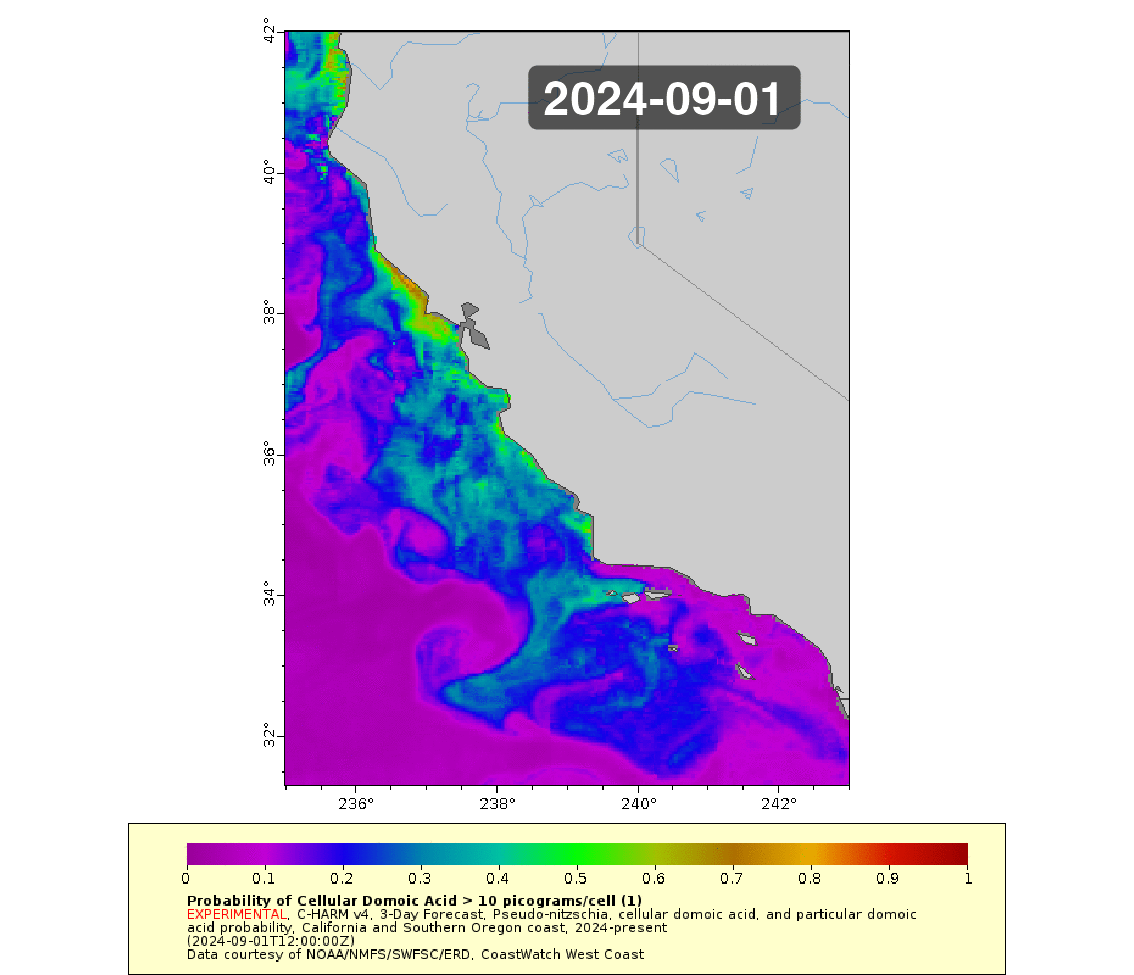
Pseudo-nitzschia
Pseudo-nitzschia is a neurotoxin producing diatom that is observed along the California Coast. Blooms of this phytoplankton can be detrimental to surrounding marine ecosystems. This forecast provides a probability for where the concentration of cells in the water exceed the threshold of a Harmful Algal Bloom ( > 10,000 cells/L).
The C-HARM v3 model generates nowcast and forecasts of the probability of Pseudo-nitzschia concentrations of in excess of 10,000 cells/L, the probability of particulate domoic acid > 500 nanograms/L, and the probability of cellular domoic acid > 10 picograms/cell in California and Southern Oregon coastal waters. Inputs for the model include near real-time satellite observations, gap-filled chlorophyll a, 486nm reflectance, and 551nm reflectance fields from the S-NPP NOAA VIIRS sensor plus nowcast and forecast data of surface salinity, sea surface temperature, and surface currents from WCOFS ROMS.
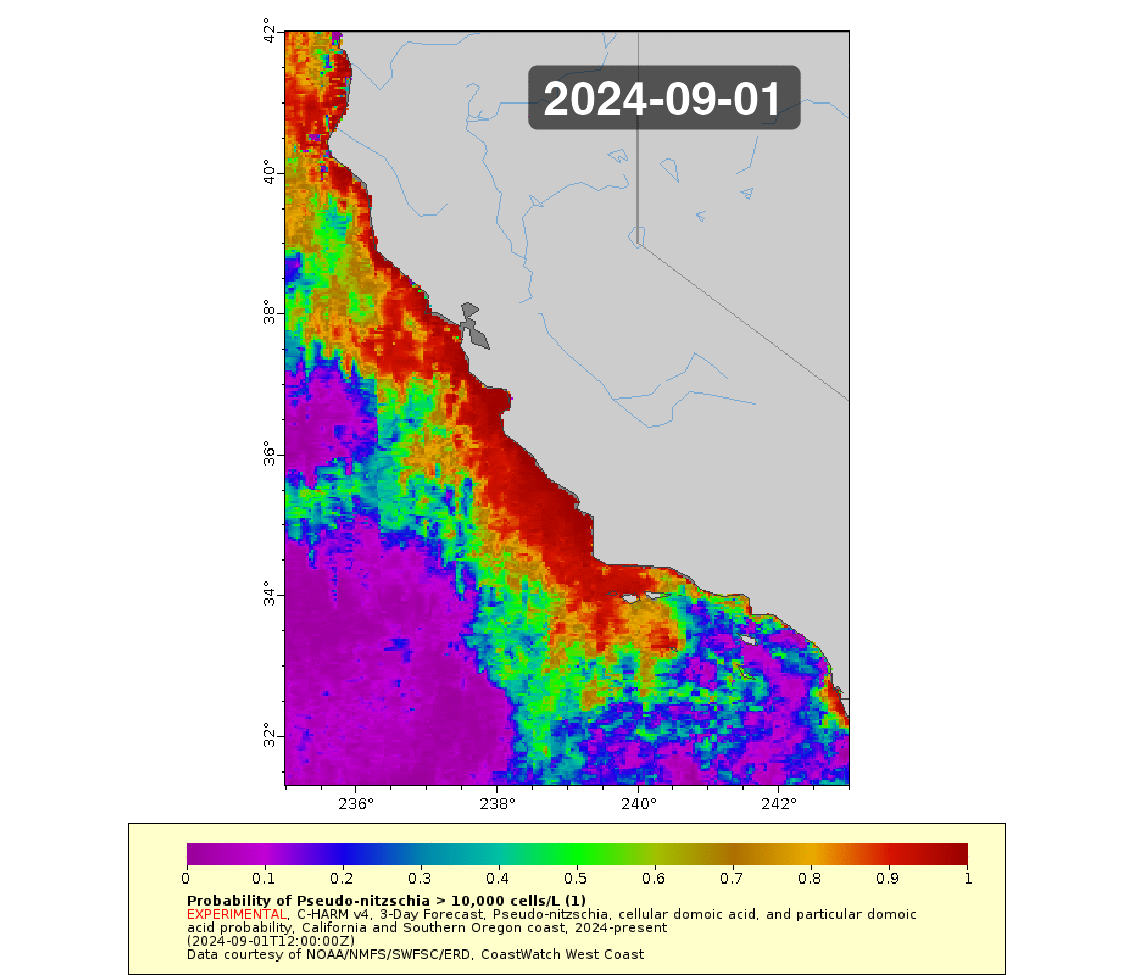
October 2024
– HAB Bulletin v2 –
The team welcomes any and all feedback on this new format of the California Harmful Algal Bloom bulletin, and extend our gratitude for your continued patience as we work through delays in development & data availability.
- SUMMARY:At the beginning of October, over ten Ca Sea Lion stranding cases in central California and fewer peppered throughout southern California seemed to be spillover from the September domoic acid (DA) resurgence. There is a slight indication of mid- month bloom conditions at some nearshore sites and scattered high- DA conditions in northern California where the Dungeness crab fishery opening was delayed in November due, in part, to high levels of DA.
- The C-HARM system predicted high probabilities of particulate DA events across a broad coastal swath from central to northern California throughout September, with high probabilities restricted to the coastline in the Southern California Bight region; Pseudo-nitzschia bloom probabilities followed the same pattern. High cellular DA event probabilities were shifted to central and northern California. This is consistent with the highest numbers of animals stranding from suspected DA toxicosis occurring in the Santa Barbara Channel and San Luis Obispo areas, as we saw earlier in the summer.
- HABMAP sampling at shore stations throughout California caught the early rise of the more toxigenic Pseudo-nitzschia “seriata” size class at Stearns Wharf (Santa Barbara) in early September before it hit bloom levels (>10,000 cells/L). We did not see the same rise in any Pseudo-nitzschia cells at Cal Poly Pier, suggesting a Santa Barbara Channel origin to this bloom. HABMAP hero, Amber Briesach, notes for Stearns Wharf: “Higher DA concentrations occurred when there were high numbers of PN “seriata” cells present in the water column. PN “delicatissima” was noted on all days sampled except September 23rd, which was also the highest DA concentration seen at the [Stearns] Wharf in the past several years. The rise in DA from early to mid September at Stearns Wharf coincided with a rapid increase along the SB Channel and central coast region of CA Sea Lion strandings with symptoms of DA intoxication. These numbers peaked in mid September. Even though some animals, albeit fewer, did strand further south in Los Angeles, Orange County, and San Diego, HABMAP sites in that region did not record any DA activity and only caught bloom levels of Pseudo-nitzschia “delicatissima” at one site, Newport Beach Pier, on Sep 23rd. Northern California shore stations were fairly quiescent in September based on the level of data collected by HABMAP, leading to a lifting of the ASP advisory from CDPH in Humboldt County on October 8th.
- Imaging FlowCytobot (IFCB) imagery collected at five sites in California is somewhat consistent with HABMAP weekly sampling at four of those same sites; machine learning algorithms generate identifications and rough estimates of abundance. At Santa Cruz Wharf, Pseudo-nitzschia were not detected by IFCB in September, and no HABMAP data are yet available with which to compare. Offshore in the Monterey Bay, the MBARI Power Buoy’s IFCB did not detect many Pseudo-nitzschia either, supporting our theory of a more central coast or Santa Barbara Channel origin of this latest bloom. Interestingly, the Stearns Wharf IFCB detected relative abundances of Pseudo-nitzschia spp. that were fairly high in early September, with persistence throughout the month, but never did detect bloom levels of Pseudo-nitzschia, which is inconsistent with HABMAP weekly sampling at the same pier. This discrepancy may point to differing depths of water collection or to challenges with imaging fragile diatom chains with the IFCB. However, in the earlier summer bloom, high abundances of Pseudo-nitzschia were recorded at the Stearns Wharf IFCB. Newport Beach Pier, Del Mar Mooring, and Scripps pier IFCBs all detected Pseudo-nitzschia , with relative abundances at Scripps Pier the highest of all IFCBs in September, even dominated 100% of the community in mid-September. Del Mar mooring data suggest a significant offshore presence in the San Diego area as well. [Note there are no HABMAP data from Scripps Pier yet available for September with which to compare at this time.] The relatively high abundances at Scripps Pier and Del Mar point to localized blooms in southern California that may have contributed to stranded animals in the San Diego area and is consisent with C-HARM predictions of local nearshore DA events in southern California the area in September.
- CDPH plankton sampling corresponds with peak animal strandings in that the P. “seriata” size class was observed as Abundant in mid September at sampling sites in Santa Barbara and San Luis Obispo Counties in mid September (no late Sep sampling in those areas). This diverges from HABMAP monitoring, which only picked up bloom levels of Pseudo-nitzschia (less toxigenic “deli” size class) at Cal Poly Pier on 1 September. Due to the combined CDPH and HABMAP sampling, the CDPH Biotoxin Monitoring program reissued an advisory on September 26th warning the public not to consume recreationally harvested bivalves from Santa Barbara County due to the risk of Amnesic Shellfish Poisoning after having lifted a similar advisory on Sep 3rd. All ASP advisories for Santa Barbara County are now lifted as well as the statewide annual quarantine due to DA that ended on October 31st.
- Alexandrium spp. activity tapered off in the month of September relative to the summer blooms that led to Paralytic Shellfish Poisoning (PSP) advisories. There were still high abundances recorded by HABMAP at Cal Poly Pier on 1 September (>6,000 cells/L) and Bodega Marine Laboratory on 3 September (~600 cells/L), the latter corroborating CDPH sampling in Marin that yielded Common abundances of Alexandrium spp. CDPH did lift the PSP advisory for Santa Cruz County on October 23rd.
Particulate Domoic Acid
Particulate domoic acid (pDA) is the measurement of total domoic acid toxin that is potentially extant in a given area. This forecast provides a probability for where that concentration of toxin is predicted to exceed the threshold that classifies a Harmful Algal Bloom (> 500 nanograms per liter).
The C-HARM v3 model generates nowcast and forecasts of the probability of Pseudo-nitzschia concentrations of in excess of 10,000 cells/L, the probability of particulate domoic acid > 500 nanograms/L, and the probability of cellular domoic acid > 10 picograms/cell in California and Southern Oregon coastal waters. Inputs for the model include near real-time satellite observations, gap-filled chlorophyll a, 486nm reflectance, and 551nm reflectance fields from the S-NPP NOAA VIIRS sensor plus nowcast and forecast data of surface salinity, sea surface temperature, and surface currents from WCOFS ROMS.

Cellular Domoic Acid
Cellular domoic acid (cDA) is the measure of total domoic acid toxin calculated per cell of Pseudo-Nitzchia. This forecast provides a probability for where those cells are expected to be producing toxin at high levels (> 10 picograms per cell).
The C-HARM v3 model generates nowcast and forecasts of the probability of Pseudo-nitzschia concentrations of in excess of 10,000 cells/L, the probability of particulate domoic acid > 500 nanograms/L, and the probability of cellular domoic acid > 10 picograms/cell in California and Southern Oregon coastal waters. Inputs for the model include near real-time satellite observations, gap-filled chlorophyll a, 486nm reflectance, and 551nm reflectance fields from the S-NPP NOAA VIIRS sensor plus nowcast and forecast data of surface salinity, sea surface temperature, and surface currents from WCOFS ROMS.

Pseudo-nitzschia
Pseudo-nitzschia is a neurotoxin producing diatom that is observed along the California Coast. Blooms of this phytoplankton can be detrimental to surrounding marine ecosystems. This forecast provides a probability for where the concentration of cells in the water exceed the threshold of a Harmful Algal Bloom ( > 10,000 cells/L).
The C-HARM v3 model generates nowcast and forecasts of the probability of Pseudo-nitzschia concentrations of in excess of 10,000 cells/L, the probability of particulate domoic acid > 500 nanograms/L, and the probability of cellular domoic acid > 10 picograms/cell in California and Southern Oregon coastal waters. Inputs for the model include near real-time satellite observations, gap-filled chlorophyll a, 486nm reflectance, and 551nm reflectance fields from the S-NPP NOAA VIIRS sensor plus nowcast and forecast data of surface salinity, sea surface temperature, and surface currents from WCOFS ROMS.

California Harmful Algal Bloom Monitoring & Alert Program
Differentiating Pseudo-nitzschia species by light microscopy is difficult. For this reason, Pseudo-nitzschia “seriata” does not refer to an actual species but rather the larger size class of Pseudo-nitzschia, which is generally a more toxigenic group of species. Alternatively, Pseudo-nitzschia “delicatissima” refers to the smaller size class that is generally non-toxigenic. The dashed line on the plots demarcates the 10,000 cells/L “bloom” threshold designated here for Pseudo-nitzschia populations only.
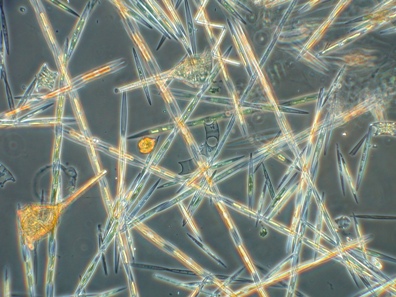
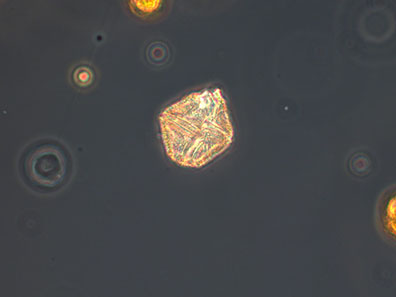
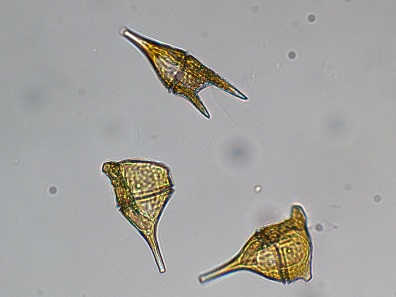
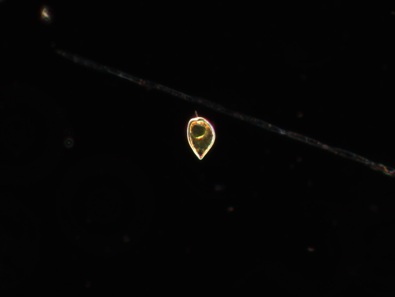

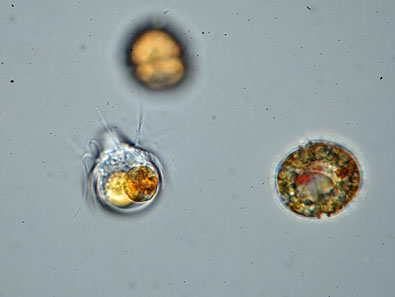
These time series focus on data collected through the scope of this bulletin and the 12 month period that precedes it. Explore the variables and regions that make up the CalHABMAP collective dataset using the plot controls.
More information and data visualizations on the statewide HAB network and forecasting system is found on the California HABMAP website and on the SCCOOS Harmful Algal Bloom page.
Domoic acid (DA) is a potent neurotoxin produced by some diatom species of the genus Pseudo-nitzschia. Species exposed to DA can result in seizures, epilepsy, cardiomyopathy, and death depending upon the ingested dose. DA toxicosis commonly occurs in California sea lions (Zalophus californianus), presumably due to a combination of foraging behavior and seasonal movements.
The Marine Mammal Center (TMMC), Channel Islands Marine Wildlife Institute (CIMWI), California Wildlife Center (CWC), Marine Mammal Care Center Los Angeles (MMCC-LA), Pacific Marine Mammal Center (PMMC), SeaWorld, and Southwest Fisheries Science Center (SWFSC) act like an emergency room by working to rescue and rehabilitate sick and injured marine mammals, seabirds, and sea turtles.
During event peaks, the workload of these care centers can become quickly overwhelming. The following chart is graciously collated from the dedicated members of our stranding network. Exact dates and counts during this phase are approximations based on center’s reports.

Each month, water samples are collected by volunteers and sent to the California Department of Public Health (CDPH) for analysis.
The relative abundance of DA-producing Pseudo-nitzschia ‘seriata’ size class (left) and PSP toxin-producing Alexandrium spp. are catalogued (right):
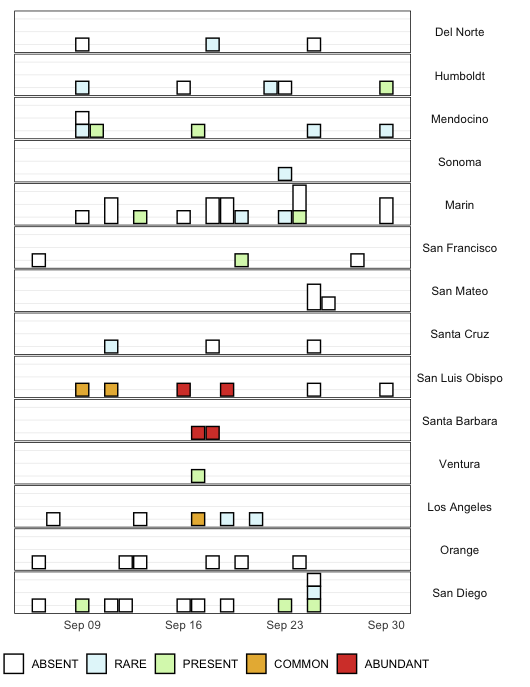
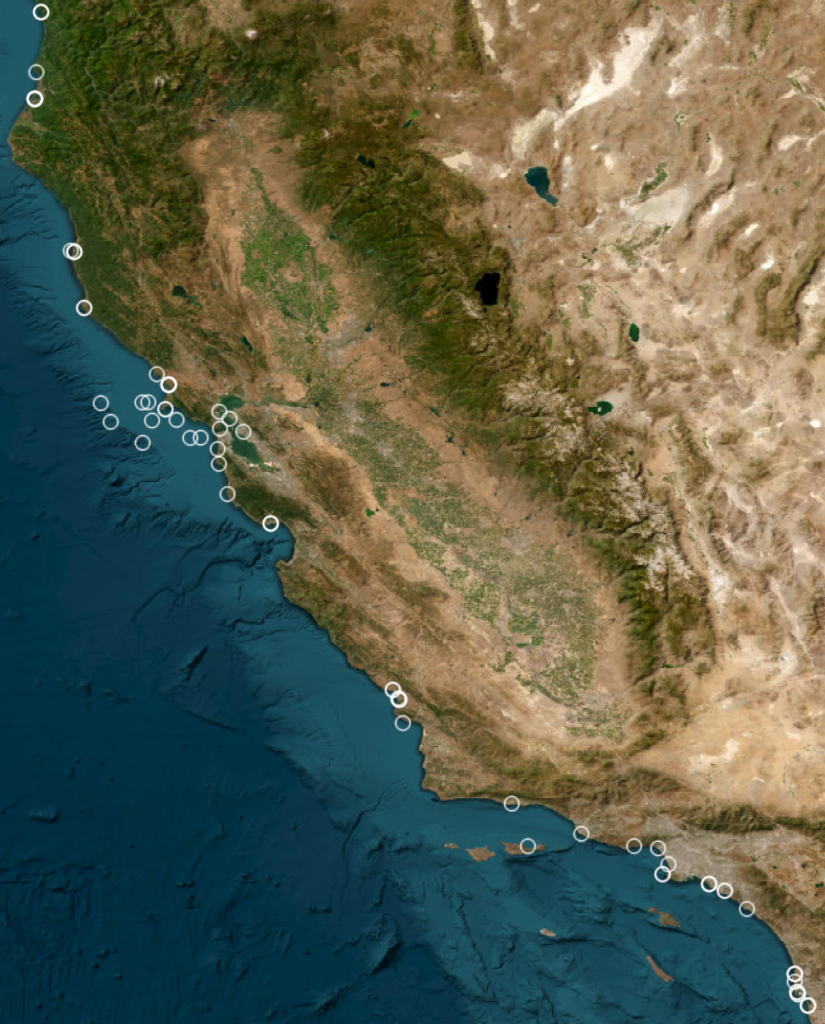
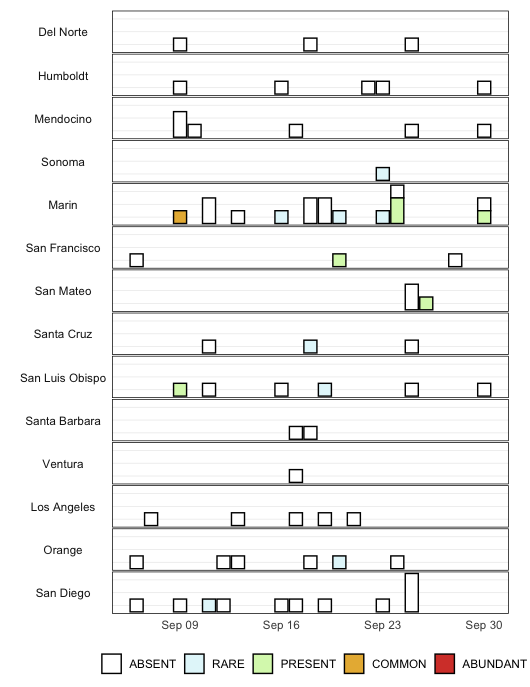
Water Sample Detailed Data
| Date_Sampled | County | Sample_Site | PN_Percent_Comp | PN_Density | AL_Percent_Comp | AL_Density |
|---|---|---|---|---|---|---|
| 2024-09-19 | San Luis Obispo | Port San Luis, Diablo Cove | 87 | ABUNDANT | 0.5 | RARE |
| 2024-09-17 | Santa Barbara | Santa Cruz Is., Prisoners Hrbr | 76 | ABUNDANT | 0 | ABSENT |
| 2024-09-16 | San Luis Obispo | Morro Bay, Boat Launch | 50 | ABUNDANT | 0 | ABSENT |
| 2024-09-18 | Santa Barbara | Goleta Pier | 50 | ABUNDANT | 0 | ABSENT |
| 2024-09-11 | San Luis Obispo | Cayucos Pier | 20 | COMMON | 0 | ABSENT |
| 2024-09-09 | San Luis Obispo | Morro Bay, Boat Launch | 15 | COMMON | 5 | PRESENT |
| 2024-09-17 | Los Angeles | Santa Monica Bay, 3901 | 12 | COMMON | 0 | ABSENT |
| 2024-09-10 | Mendocino | Mendocino, Noyo OFFSHORE | 8 | PRESENT | 0 | ABSENT |
| 2024-09-30 | Humboldt | Humboldt Bay, Indian Is. Ch. | 5 | PRESENT | 0 | ABSENT |
| 2024-09-24 | Marin | GFNMS, Marin Line 2W | 3.5 | PRESENT | 0 | ABSENT |
| 2024-09-17 | Ventura | Ventura, Port Hueneme Pier | 3 | PRESENT | 0 | ABSENT |
| 2024-09-20 | San Francisco | GFNMS, San Francisco Line N6WN | 3 | PRESENT | 3 | PRESENT |
| 2024-09-17 | Mendocino | Mendocino, Noyo Harbor | 3 | PRESENT | 0 | ABSENT |
| 2024-09-13 | Marin | Point Richmond, Ferry Point | 2 | PRESENT | 0 | ABSENT |
| 2024-09-25 | San Diego | La Jolla, Scripps Pier | 1 | PRESENT | 0 | ABSENT |
| 2024-09-23 | San Diego | La Jolla, Scripps Pier | 1 | PRESENT | 0 | ABSENT |
| 2024-09-09 | San Diego | La Jolla, Scripps Pier | 1 | PRESENT | 0 | ABSENT |
| 2024-09-09 | Humboldt | Humboldt Bay, Indian Is. Ch. | 0.5 | RARE | 0 | ABSENT |
| 2024-09-11 | Santa Cruz | Santa Cruz Wharf | 0.5 | RARE | 0 | ABSENT |
| 2024-09-23 | Sonoma | Bodega Harbor, USCG Dock | 0.5 | RARE | 0.5 | RARE |
| 2024-09-23 | Marin | Tomales Bay, Lease #M430-15 | 0.5 | RARE | 0.2 | RARE |
| 2024-09-20 | Marin | GFNMS, Marin Line N4-WN | 0.5 | RARE | 0.5 | RARE |
| 2024-09-19 | Los Angeles | Hermosa Beach Pier | 0.5 | RARE | 0 | ABSENT |
| 2024-09-22 | Humboldt | Trinidad Pier | 0.5 | RARE | 0 | ABSENT |
| 2024-09-18 | Del Norte | Wilson Creek | 0.5 | RARE | 0 | ABSENT |
| 2024-09-25 | San Diego | San Diego Harbor, Pier 159 | 0.5 | RARE | 0 | ABSENT |
| 2024-09-21 | Los Angeles | Palos Verdes Rocky Pt Offshore | 0.5 | RARE | 0 | ABSENT |
| 2024-09-09 | Mendocino | Mendocino, Noyo Harbor | 0.5 | RARE | 0 | ABSENT |
| 2024-09-30 | Mendocino | Point Arena Pier | 0.5 | RARE | 0 | ABSENT |
| 2024-09-25 | Mendocino | Mendocino, Noyo Harbor | 0.5 | RARE | 0 | ABSENT |
| 2024-09-06 | San Francisco | San Francisco Bay, Golden Gate | 0 | ABSENT | 0 | ABSENT |
| 2024-09-09 | Marin | Tomales Bay, Lease #M430-15 | 0 | ABSENT | 10 | COMMON |
| 2024-09-11 | Marin | Drakes Bay, Chimney Rock LBS | 0 | ABSENT | 0 | ABSENT |
| 2024-09-16 | Marin | Tomales Bay, Lease #M430-15 | 0 | ABSENT | 0.5 | RARE |
| 2024-09-16 | Humboldt | Humboldt Bay, Indian Is. Ch. | 0 | ABSENT | 0 | ABSENT |
| 2024-09-11 | Marin | San Rafael, Loch Lomond | 0 | ABSENT | 0 | ABSENT |
| 2024-09-12 | San Diego | Imperial Beach Pier | 0 | ABSENT | 0 | ABSENT |
| 2024-09-13 | Orange | Bolsa Chica | 0 | ABSENT | 0 | ABSENT |
| 2024-09-13 | Los Angeles | Santa Monica Pier | 0 | ABSENT | 0 | ABSENT |
| 2024-09-16 | San Diego | Imperial Beach Pier | 0 | ABSENT | 0 | ABSENT |
| 2024-09-07 | Los Angeles | Palos Verdes Rocky Pt Offshore | 0 | ABSENT | 0 | ABSENT |
| 2024-09-18 | Santa Cruz | Santa Cruz Wharf | 0 | ABSENT | 0.5 | RARE |
| 2024-09-24 | Marin | GFNMS, Marin Line N2WN | 0 | ABSENT | 2 | PRESENT |
| 2024-09-19 | Marin | GFNMS, Marin Line 4W | 0 | ABSENT | 0 | ABSENT |
| 2024-09-23 | Humboldt | Humboldt Bay, Indian Is. Ch. | 0 | ABSENT | 0 | ABSENT |
| 2024-09-30 | Marin | Drakes Bay, Chimney Rock LBS | 0 | ABSENT | 4 | PRESENT |
| 2024-09-26 | San Mateo | Pacifica Pier | 0 | ABSENT | 1 | PRESENT |
| 2024-09-25 | Santa Cruz | Santa Cruz Wharf | 0 | ABSENT | 0 | ABSENT |
| 2024-09-19 | Marin | GFNMS, Marin Line 4E | 0 | ABSENT | 0 | ABSENT |
| 2024-09-18 | Marin | GFNMS, San Francisco Line 6E | 0 | ABSENT | 0 | ABSENT |
| 2024-09-18 | Marin | GFNMS, San Francisco Line 6W | 0 | ABSENT | 0 | ABSENT |
| 2024-09-24 | Marin | GFNMS, Marin Line 2E | 0 | ABSENT | 1 | PRESENT |
| 2024-09-25 | San Mateo | Bean Hollow State Beach | 0 | ABSENT | 0 | ABSENT |
| 2024-09-30 | San Luis Obispo | Morro Bay, Boat Launch | 0 | ABSENT | 0 | ABSENT |
| 2024-09-30 | Marin | Tomales Bay, Lease #M430-15 | 0 | ABSENT | 0 | ABSENT |
| 2024-09-17 | San Diego | Pacific Beach Pier | 0 | ABSENT | 0 | ABSENT |
| 2024-09-19 | San Diego | San Diego Bay, U.S. Navy Pier | 0 | ABSENT | 0 | ABSENT |
| 2024-09-24 | Orange | Newport Bay, Back Bay | 0 | ABSENT | 0 | ABSENT |
| 2024-09-25 | San Mateo | Pillar Point Harbor | 0 | ABSENT | 0 | ABSENT |
| 2024-09-06 | San Diego | San Diego Bay | 0 | ABSENT | 0 | ABSENT |
| 2024-09-11 | San Diego | San Diego Bay | 0 | ABSENT | 0.5 | RARE |
| 2024-09-09 | Mendocino | Point Arena Pier | 0 | ABSENT | 0 | ABSENT |
| 2024-09-12 | Orange | Newport Bay, Back Bay | 0 | ABSENT | 0 | ABSENT |
| 2024-09-25 | San Diego | Imperial Beach Pier | 0 | ABSENT | 0 | ABSENT |
| 2024-09-25 | Del Norte | Wilson Creek | 0 | ABSENT | 0 | ABSENT |
| 2024-09-06 | Orange | Bolsa Chica | 0 | ABSENT | 0 | ABSENT |
| 2024-09-09 | Del Norte | Wilson Creek | 0 | ABSENT | 0 | ABSENT |
| 2024-09-20 | Orange | Bolsa Chica | 0 | ABSENT | 0.5 | RARE |
| 2024-09-28 | San Francisco | Oakland, Jack London Aquatic | 0 | ABSENT | 0 | ABSENT |
| 2024-09-18 | Orange | Dana Pt. Harbor | 0 | ABSENT | 0 | ABSENT |
| 2024-09-25 | San Luis Obispo | Cayucos Pier | 0 | ABSENT | 0 | ABSENT |
Percent composition categories help us look at phytoplankton trends across an entire region to evaluate risk of biotoxin presence. Many other factors contribute to our evaluation of risk in an area. These samples are posted for informational purposes only. They are not intended to inform the public of the presence or lack of risk. For the latest health advisory information, see the CDPH Health Advisory Map below.
A network of Imaging FlowCytobots (IFCBs) continuously photographs particles, such as plankton, in the water. Using machine learning, plankton species can be automatically identified. This will help improve the ability to detect and respond to Harmful Algal Blooms, including the ability to assess conditions that may lead to toxin production or blooms of toxin-producing algae.
These data, coupled with the image classification algorithms developed in collaboration with SCCOOS and CeNCOOS, allow for estimates of species composition over time. The time series below depict sampling outcomes across several California sites. Support provided by NOAA IOOS and CA OPC.
Additional images and data are available on the IFCB dashboard. NOTE: Eight shore station and offshore mooring sites are equipped with IFCBs, and five were generating data in September.]
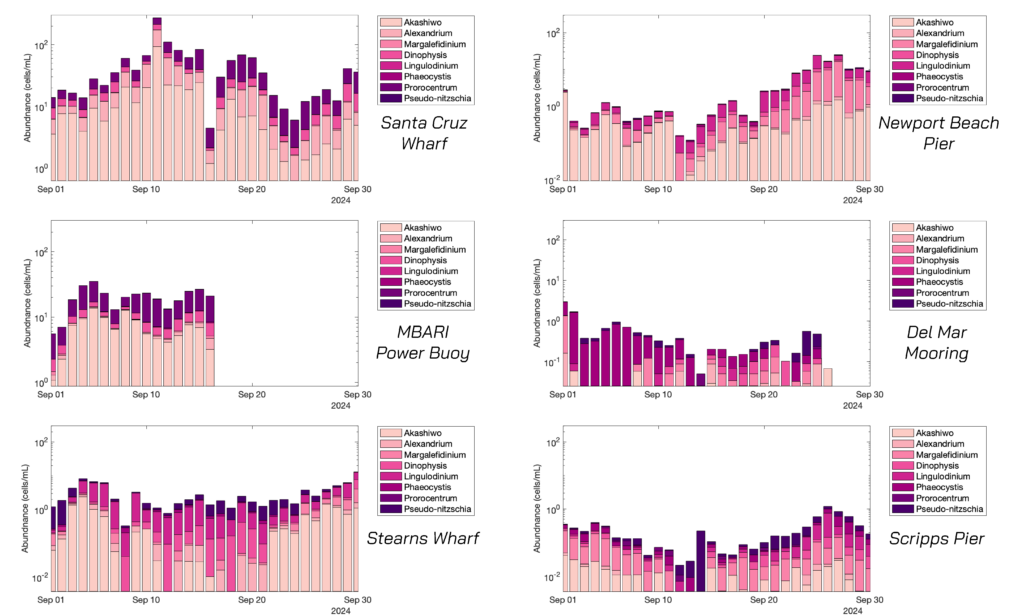
California HAB Bulletin
All data and reports have been synthesized by SCCOOS for the California Harmful Algal Bloom Monthly Bulletin.
Data Access & Resources:
C-HARM, NOAA CoastWatch ERDDAP
Toxic Phytoplankton Observations, CDPH
Imaging FlowCytoBot Dashboard
CalHABMAP Datasets, SCCOOS ERDDAP

